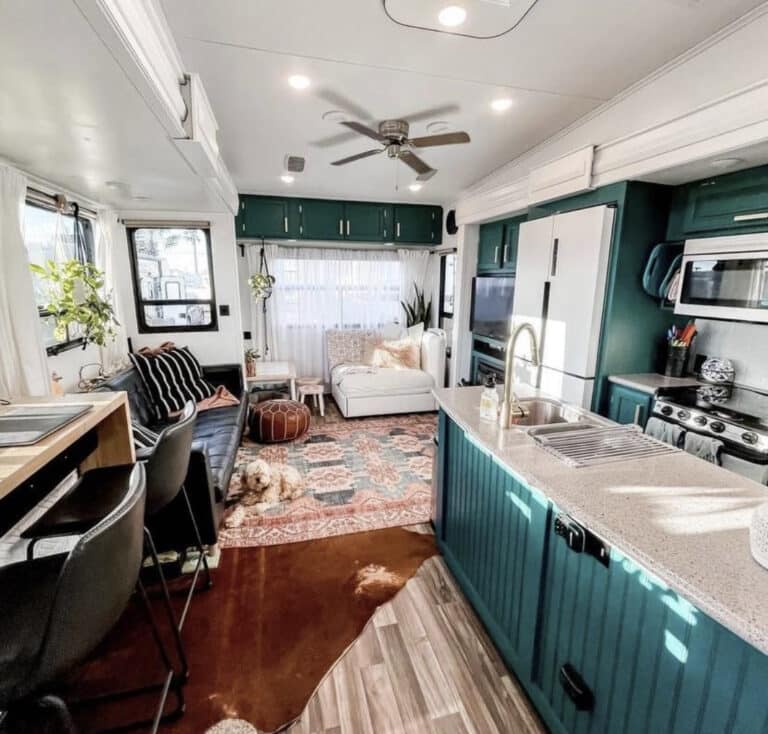How to Fix RV Roof Leaks in 5 Painless Steps
This post may contain affiliate links.
If you’re looking for info on how to fix a leaking camper roof, you’ve come to the right place. This post includes a breakdown of how you can best assess a roof leak in an RV and a guide on how to fix RV roof leaks.
Disclaimer: I am not a professional RV technician, just a guy who’s spent a good bit of time on the roof of his RV. This post is for informational purposes and focuses on DIY fixes for small-scale leaks rather than replacing or resealing the entire roof. Always consult with a professional before undertaking roof repairs.
There are only two types of RVs: those with roof leaks and those that aren’t leaking yet. Keeping your roof clean and properly maintained will help. Still, no amount of maintenance will preclude the possibility of roof leaks.
When we purchased our toy hauler, I was excited to get an RV with a solid aluminum roof because, allegedly, aluminum roofs never leak. That turned out to be false.
It leaks, and about once a year, I find myself atop a tall ladder on the hunt for the newest leak, armed with a caulk gun and much frustration. In reality, RV roofs take a beating from the elements and the rigors of being pulled around the country at highway speeds. Roof leaks are just part of the journey.
Count yourself lucky if the leak fairy hasn’t visited your rig yet. When that first leak does show up, here are a few tips for finding and stopping roof leaks quickly and effectively.
Related Articles on Repairing RV Water Damage
If your RV has water damage related to caused by a roof leak, you’ll want to check out these related articles:
- DIY RV Slide Out Roof Repair: How to Fix a Leaking Camper Roof (With Photos)
- Camper Wall Repair: How to Fix Walls and Replace Wallpaper in Camper Interiors
- How to Replace Your RV Subfloor If You Find Water Damage
How to Fix a Leaking Camper Roof in 5 Steps
If your roof is already leaking, consider grabbing an inexpensive RV roof cover to keep it protected until you can fully complete this project.
Step 1: Figure Out What Your RV Roof is Made of
Check the owner’s manual specifications to determine what your RV roof is made of. Doing this is important because the material used may limit your repair options. If you don’t have a manual handy, give it a Google and see if you can locate the specifications for your exact model and year online.
The most common roof materials are aluminum, rubber (EPDM or TPO), fiberglass, or PVC.
Aluminum and fiberglass should be fairly easy to identify. Aluminum is metal and may have some flex in it, while fiberglass is heavier-duty and more rigid.
Identifying the material used can be more difficult if you have a membrane roof (EPDM, TPO, or PVC). Hopefully, the owner’s manual will provide confirmation.
If you need help finding documentation for your exact model or need clarification on what material was used, you can find some helpful tips for identifying your RV’s membrane roofing on YouTube.
Step 2: Inspect the Usual Suspects
Use a ladder or scaffolding to get a bird’s eye view of your roof and give it a once over. Understand, though, it’s not a given that you can walk around on your RV’s roof. Check the manual or contact the manufacturer to verify that it will support your weight before venturing onto the roof.
It’s common belief that campers with a built-in ladder for roof access are safe to walk on if the RV is in good condition, but always verify the weight capacity with the manufacturer.

Once you’re up there, take it slow. Don’t be the person who brings a caulk gun onto the roof and seals over every seam and penetration before conducting a thorough inspection.
That approach makes a mess and will only obscure the real problem. It’s better to be thorough, methodical, and thoughtful.
The first thing to look for is apparent damage in the area above where the leak occurred.
Depending on your roof type, signs of trouble may include a puncture, discoloration, peeling, dents, or low spots.
If you don’t see anything obviously wrong, focus on the seams and penetrations.
The seams are the corners and joints where the main horizontal expanse of your roof connects to the vertical walls on all four sides.
The roof penetrations include the rooftop AC units, skylights, plumbing vent pipes, antennas, and exhaust fans.
In each location, you’ll see sealant where the materials connect. Inspect the sealant, looking for cracks, separation, holes, or any other indications of deterioration.
Inspecting a pop-up camper roof? The process is a bit different. Read this next: 6 Tips for Inspecting a Used Pop-Up Camper
Don’t Forget to Check Your Running Lights
In addition to inspecting the seams, I recommend inspecting any marker lights (AKA running lights) on the RV. These are typically small orange or red lights along the top of the exterior walls of the RV.
While marker lights help increase the nighttime visibility of your rig to other drivers, they are notorious for causing leaks. If there’s no evident damage on the roof and you don’t see any faulty joints or penetrations, inspect all the running lights in the leak area.
RV roof leaks can occur when a light wiggles loose and is no longer securely fastened to the RV or when it cracks or breaks. If you notice caulk around any of the lights, that’s a sure indication of a previous leak.
Step 3: Assess Your Repair Options

When figuring out how to fix a leaking camper roof, the scope of the damage and scale of necessary repairs are the best indications of what to do next. Based on your level of knowledge, experience, and ability, consider what needs to be done and if you can do it safely. Leaning off of ladders and walking around on shaky RV roofs isn’t a great choice for everyone, and it’s best to hire a pro if you have any doubts.
At the very least, most repairs will require accessing the roof, scraping and removing the sealant in the leak area, preparing the surface, and applying new sealant or tape.
Many people are capable of sealing a few minor leaks. The difficulty level increases when more complex repairs are required, such as resealing or replacing an entire membrane roof. In these cases, getting an estimate from a professional might be best before pricing the materials and tools for a DIY job.
Supplies Needed to Fix RV Roof Leaks
If you choose to proceed with fixing the leak yourself, you’ll need the following supplies, depending on the repairs needed:
- Soap
- Denatured alcohol or mineral spirits*
- Rags or shop clothes
- Scrub brush
- Scraper
- Disposable gloves (I prefer heavy-duty nitrile.)
- Safety glasses
- Small knife or box cutter
- RV roof sealant
*Before using denatured alcohol or mineral spirits to clean the surface, confirm that it will be compatible with the sealant.
A Word on Sealant Options
A self-leveling RV roof sealant is the go-to for minor repairs for most RVers.
- Creates a secure, secondary seal along the roof’s edges, air vents, vent pipes and screw heads
Self-leveling RV roof sealants are desirable because they spread out, flatten, and seep down into holes and cracks to create a uniform seal. They are designed to be flexible enough to withstand the shock and vibration experienced by a typical RV roof.
Other options include UV-stable roof repair tapes, butyl tapes, liquid rubber, and silicone products. Many RVers have had good results with repair tapes, but your mileage may vary on these products. My main hesitation for using them is that they are all difficult to remove – especially silicone.
- MULTI-USE: Perfect for use on metal buildings, trailer/RV roofs and sides, drain pans, drain pipes, boats, canoes. bonds to a wide range of surfaces including roof materials such as EPDM, TPO, Hypalon, aluminum, galvanized steel, wood, and fiberglass.
- Flex Seal Liquid is liquid rubber in a can! Now you can brush, roll, dip or pour it on!
Important: Before purchasing any sealant for your roof, ensure you know your rig’s roofing material and which sealants are safe to use. This tip is especially important for membrane roofs.
Step 4: Prepare the Roof for Resealing
Start this step by watching the weather forecast.
You need at least several hours of dry weather before you undertake the repair, and typically, a minimum of two to four hours for the new sealant to be tack-free. A few days of dry weather would be ideal, but that might be a stretch in some climates.
What you do next will be dependent on the scope of your repairs.
If you think the leak is coming from small cracks in the existing sealant, clean it with a mild detergent such as Dawn and a scrub brush. Rinse. Let it dry. Then, clean the sealant again using a solvent such as denatured alcohol, depending on the sealant you’re cleaning.
If the damage is more extensive, you may need to scrape and remove some old sealant. Gently scrape it off, taking care not to cut or puncture the roof membrane. (It’s really easy to damage the membrane beneath the sealant!)
Step 5: Apply New Sealant or Tape
Once the surface is fully prepared and dried, apply the new sealant per the instructions.
It doesn’t have to be a beautiful job, but it needs to be thorough.
Apply a thick bead of sealant over the cracks. (You can use the tip of the caulk tube or a scraper to work the sealant down into the cracks.) As the sealant cures, it will spread out and level itself.

If you choose to use a tape sealant, first clean the area as described above. Wipe it dry and then allow the surface to dry in the sun before applying the tape per the instructions. When you apply the tape, be sure to press each piece down completely, removing any air bubbles and forcing the tape down all the way to the surface in any low spots.
Advice on Preventing RV Roof Leaks in the Future
An ounce of prevention goes a long way in minimizing the number of roof leaks you will encounter.
The primary maintenance to be performed is just cleaning the roof and removing debris such as leaves and dirt. Especially if the RV is “dry docked” for a while. Piles of leaves or pine straw can impede rainwater flow off the roof and lead to other problems.

However, RV roofs always need to be resealed periodically, typically ranging from every one to three years, depending on the material and the sealants used. If you go beyond three years without resealing, it becomes more likely that you will experience problems.
How Long Does an RV Roof Last? And When Do I Know if it’s Time for a Replacement?
The lifespan of RV roofs varies widely depending on quality, material, and the level of maintenance they have received.
Ten to twenty years is a reasonable estimate for the entire lifespan of a roof.
If you think you might need a new roof, I suggest getting it inspected and priced by a professional before attempting to address large-scale leaks on your own. A roof near the end of its lifespan will be an uphill battle for a DIYer. And then all of your time, effort, and costs could be wasted if it’s time for a new roof.
Conclusion: How to Fix Leak in RV Roof
Roof leaks are one of the great common denominators of RV life. Every RV, from the snazziest class A to the most frugal and utilitarian travel trailer, will leak at some point. So don’t worry about it.
Next time you’re parked somewhere dry for a few days, get a ladder and do some basic inspection maintenance. Take a few photos of any areas that look sketchy so you can check on them later and note any deterioration.
As you familiarize yourself with the roof, you will become more confident and prepared to address the leaks that will eventually come your way.
More Info On Repairing Water Damage in an RV
If you’re looking for information on how to fix a leak in a camper roof, there’s a pretty good chance you have water damage elsewhere in your RV. In that case, you may want to take a look at these related guides:
- DIY RV Slide Out Roof Repair: How to Fix a Leaking Camper Roof (With Photos)
- Camper Wall Repair: How to Fix Walls and Replace Wallpaper in Camper Interiors
- How to Replace Your RV Subfloor If You Find Water Damage
FAQs Related to Fixing RV Roof Leaks
Our answers to frequently asked questions about repairing RV roof leaks:
What are some tips for how to fix a leak in a camper roof?
Don’t procrastinate. Leaks only get worse and more expensive to fix over time.
How long should an RV roof last?
It’s hard to say, as many different makes and models exist. Somewhere between 10 and 20 years is a good guess. If you live in a more extreme climate, the elements will degrade the roof much faster.
What is the best trailer roof sealant?
Dicor self-leveling RV roof sealants are considered by many to be the go-to product for most applications. There are comparable products available.
- Creates a secure, secondary seal along the roof’s edges, air vents, vent pipes and screw heads
What is the best temperature for repairing RV roof leaks?
It depends on the sealant you use. Most products are designed to cure the fastest around “room temperature,” which is typically around 60 or 70 degrees. Check the instructions on the sealant of your choice to confirm.
Is it OK to use Flex Seal on an RV roof?
It depends on who you ask. Some RVers like them, while others advise against them. I’ve used Flex Seal products for quick, temporary repairs to our RV’s walls, and they worked well. My only complaint is that they are hard to remove.
Does RV insurance cover roof leaks?
It depends on your policy terms and what caused the roof leak. If the leak was caused by a sudden and unexpected event, such as a tree limb falling during a storm, I would expect that most insurance policies would cover it. However, I doubt it would be covered if the leak resulted from normal wear and tear or poor maintenance. Check your policy to know for sure.
Planning a top-to-bottom RV renovation? Check out our article, How to Remodel an RV: A Guide for RV Owners.
William is a consultant and technical writer who full-timed with his wife and two kids for 2 years. He’s a builder, fixer, and tinkerer by nature, and outside of work he’s usually making, fixing, or breaking one thing or another. William’s hobbies include RVing, camping, cycling, and spending time outdoors with his family. You can find him on LinkedIn.















Thanks for sharing the great description about how to fix RV roof leaks. RV roofs are a common problem that every RV owner faces. Leaks are the real enemies when it comes to destroying your livingspace. and worsen if not repaired timely. Well, if my RV roof leaks due to any incident, then I always repair my RV roof with “Liquid roof” as it effectively seals all kinds of leaks, gaps, and minor openings and holes and dries into a watertight, flexible coating that stops leaks immediately, extending the RV’s roof service life for 15 to 20 years. It is highly resistive in heavy rainfall, hailstorms, and snowfall fall as it can withstand ponding water 365 days a year.